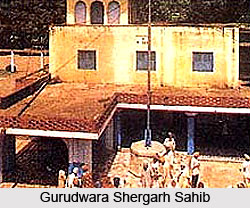 Gurudwara Shergarh Sahib is a legendary Sikh pilgrim centre, situated in Nihalgarh which is about 12km from Paonta Sahib in Sirmaur district, Himachal Pradesh. Located at the center of a popular Sikh shrines. The 10th Sikh Guru, Guru Gobind Singh decapitated a man-eating tiger at this place, this is due to a belief that the Gurdwara was built.
Gurudwara Shergarh Sahib is a legendary Sikh pilgrim centre, situated in Nihalgarh which is about 12km from Paonta Sahib in Sirmaur district, Himachal Pradesh. Located at the center of a popular Sikh shrines. The 10th Sikh Guru, Guru Gobind Singh decapitated a man-eating tiger at this place, this is due to a belief that the Gurdwara was built.
Legend of Gurudwara Shergarh Sahib
One day Guru Sahib had a meeting with Raja Medini Parkash, the Raja of Nahan, and Raja Fateh Shah, the Raja of Garhwal. A villager from the nearby village approached them and made a humble request to save the lives of the villagers from a man-eating tiger, which had killed many villagers. No one had dared to face and kill the lion till now.
It is the very site where Guru Gobind Singh, the 10th Guru of the Sikhs, had beheaded a dangerous man-eating tiger with a single swipe of the sword.
How to Reach Gurudwara Shergarh Sahib
Gurudwara Shergarh Sahib can be approached by bus from Paonta Sahib.
This article is a stub. You can enrich by adding more information to it. Send your Write Up to content@indianetzone.com





















